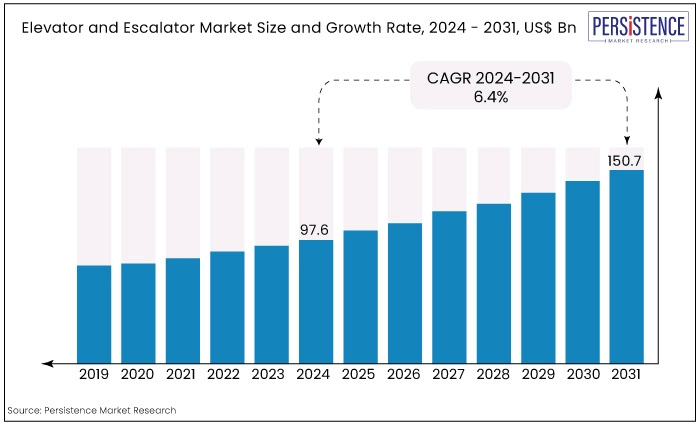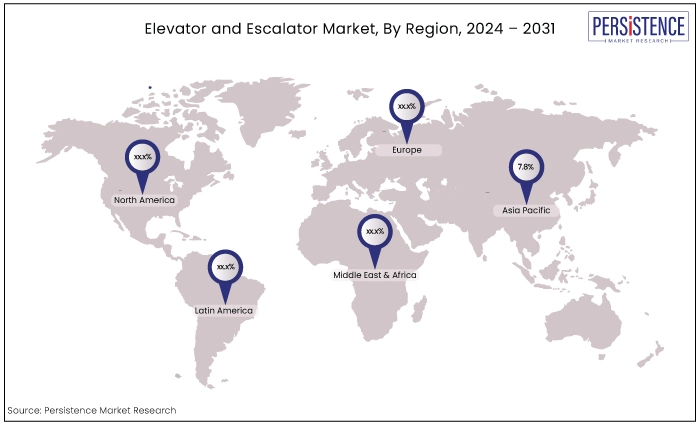Industry: Industrial Automation
Published Date: July-2024
Format: PPT*, PDF, EXCEL
Delivery Timelines: Contact Sales
Number of Pages: 168
Report ID: PMRREP34696
The global elevator and escalator market is expected to rise from US$97.6 Bn in 2024 to US$150.7 Bn by the end of 2031. The market is anticipated to secure a CAGR of 6.4% during the forecast period from 2024 to 2031.
Key Highlights of the Market
|
Attributes |
Key Insights |
|
Elevator and Escalator Market Size (2024E) |
US$97.6 Bn |
|
Projected Market Value (2031F) |
US$150.7 Bn |
|
Global Market Growth Rate (CAGR 2024 to 2031) |
6.4% |
|
Historical Market Growth Rate (CAGR 2018 to 2023) |
5.8% |
Elevators and escalators are essential components of modern urban living, providing efficient mobility solutions for people and goods in both residential and commercial settings.
A booming construction sector, particularly in residential and commercial segments, fuels the demand for elevators and escalators as new buildings are equipped with these essential vertical transportation systems.
The integration of smart features like destination control systems and real-time monitoring is making elevators and escalators more efficient and user-friendly. Also, advancements in energy-saving technologies and the use of ultra-resistant materials are attracting customers seeking sustainable and reliable solutions.
Government investments in infrastructure projects like airports, railway stations, and shopping malls further fuel the market as these facilities mainly rely on elevators and escalators.
Moreover, modernization of existing buildings and infrastructure in developing countries like China, and India is creating a need for new elevator and escalator installations.
Infrastructure development projects in emerging markets and ongoing modernization efforts in developed regions contribute significantly to market growth.

Period from 2019 to 2023 saw continued urbanization trends globally, with increasing populations migrating to cities, driving the construction of high-rise buildings and infrastructure projects.
This market trend was a primary catalyst for the demand for vertical transportation solutions, such as elevators and escalators, to efficiently move people and goods within these expanding urban landscapes. The market for elevators and escalators recorded a CAGR of captured a CAGR of 5.9% during the historical period.
The elevator and escalator market is projected to experience substantial growth from 2024 to 2031, increasing infrastructure investments, and technological advancements.
Innovations in elevator and escalator technologies, including smart elevators, destination control systems, and energy-efficient solutions, are anticipated to drive market growth.
These advancements aim to enhance user experience, improve energy efficiency, and ensure higher safety standards, thereby attracting demand across residential, commercial, and industrial sectors. The market is estimated to hold a CAGR of 6.4% during the historical period.
Increasing Infrastructure Spending in Developing Countries
Many emerging economies are focusing on modernizing and expanding their infrastructure to support economic growth and urban development. Governments allocate significant funds towards infrastructure projects, including transportation hubs, airports, metro stations, hospitals, and educational institutions.
Elevators and escalators are integral to these projects as they enhance accessibility, improve passenger flow, and contribute to the overall efficiency of public and private infrastructure.
The integration of modern vertical transportation systems in new and existing infrastructure projects stimulates market demand for advanced and reliable elevator and escalator solutions.
As infrastructure spending increases, there is a growing emphasis on adhering to international quality standards and safety regulations. Governments and project developers prioritize the installation of elevators and escalators that meet stringent safety codes and performance criteria.
Manufacturers in the elevator and escalator market respond by developing products that comply with local and international safety standards, ensuring reliability and safety in vertical transportation solutions.
Compliance with regulatory requirements enhances market confidence and encourages further adoption of elevators and escalators in infrastructure projects.
Development of Energy-Efficient Elevators and Escalators
Technological advancement driving market growth is the development of energy-efficient elevators and escalators. Manufacturers are increasingly focusing on designing systems that consume less energy during operation while maintaining high performance standards. This market trend aligns with global sustainability goals and regulations aimed at reducing carbon footprints in urban environments.
Digitalization has transformed maintenance practices in the industry. Remote monitoring and diagnostics enable service providers to detect potential issues early, schedule proactive maintenance, and minimize downtime. This shift toward predictive maintenance not only enhances equipment reliability but also reduces operational costs for building owners and facility managers.
As technology continues to evolve, the elevator and escalator market is expected to witness further innovations. Emerging technologies such as robotics for maintenance tasks, biometric access control systems, and touchless interfaces in elevators are anticipated to redefine standards of safety, convenience, and efficiency in vertical transportation systems.
High Initial Costs and Capital Intensity
One of the primary restraints for the elevator and escalator market is the high initial costs associated with installation and maintenance. Elevators and escalators are capital-intensive investments for building owners, developers, and infrastructure projects.
The costs include not only the purchase and installation of equipment but also ongoing expenses related to maintenance, repairs, and upgrades over the system's lifespan.
In emerging economies and developing regions, where budget constraints may limit infrastructure spending, the upfront capital required for elevators and escalators can be prohibitive. This can slow down adoption rates and project timelines, especially for smaller-scale developments or projects with limited financial resources.
The complexity of installation and customization requirements adds to the overall cost burden. Buildings with unique architectural designs or older structures often require customized solutions, driving up installation costs and extending project timelines.
Such factors contribute to hesitation among developers and building owners, impacting market growth particularly in regions where cost considerations are critical.
Regulatory and Safety Compliance Challenges
Regulatory requirements and safety standards pose significant challenges for the elevator and escalator industry. Governments and regulatory bodies impose stringent safety codes and compliance standards to ensure user safety, operational reliability, and environmental sustainability.
While these regulations are essential for safeguarding public health and safety, they also impose additional costs and operational complexities on manufacturers, suppliers, and service providers.
Compliance with diverse and evolving regulatory frameworks across different regions and countries requires ongoing investments in research, development, and product testing.
Manufacturers must continuously innovate to meet or exceed regulatory requirements, which can increase production costs and impact profit margins.
Moreover, delays in obtaining regulatory approvals or certifications for new products can hinder market entry and expansion efforts, limiting manufacturers' ability to introduce innovative solutions to meet market demand effectively.
Maintaining compliance with safety standards throughout the operational lifespan of elevators and escalators requires consistent monitoring, maintenance, and periodic upgrades.
Failure to adhere to regulatory requirements can lead to penalties, legal liabilities, and reputational risks for stakeholders in the elevator and escalator industry.
Integration of Smart Technologies and Digitalization
The integration of smart technologies and digitalization presents a compelling opportunity for industry participants in the elevator and escalator market. Smart elevators and escalators leverage Internet of Things, Artificial Intelligence, cloud computing, and data analytics to enhance operational efficiency, improve user experience, and optimize maintenance practices.
Smart elevators equipped with destination control systems (DCS) use algorithms to group passengers traveling to similar floors, thereby reducing wait times and improving journey efficiency.
IoT-enabled sensors monitor equipment performance in real-time, allowing predictive maintenance to address potential issues before they escalate, minimizing downtime and optimizing reliability.
Smart technologies enable elevators and escalators to operate more efficiently by adjusting power consumption based on usage patterns and traffic flow. Energy-saving features not only reduce operational costs but also align with sustainability goals, appealing to environmentally conscious consumers and building owners.
Digitalization enables industry participants to gather valuable data on usage patterns, equipment performance, and user behavior. Analyzing this data provides actionable insights for optimizing system design, enhancing maintenance schedules, and developing personalized services that cater to specific customer needs.
Elevator Segment to Exhibit the Maximum Revenue Share
Growing demand from evolving infrastructure is driving the segment growth. Urbanization trends particularly in emerging economies, are leading to increased construction of high-rise buildings and urban infrastructure projects.
Elevators are indispensable in tall structures for efficient vertical transportation of people and goods. As cities expand vertically to accommodate growing populations and optimize land use, the demand for elevators escalates, thereby driving substantial revenue growth in the elevator segment.
The rising demographic shift towards an aging population in countries like China and India is emerging as a significant catalyst for elevators, propelling market expansion.
Residential Segment to Grow Substantially to Hold a Significant Market Share
Elevators are no longer considered a luxury but a necessity in residential buildings, especially among affluent and middle-class populations seeking enhanced comfort and convenience in their living environments.
The residential sector emerged as the revenue leader in 2023 and is projected to experience the most substantial growth throughout the forecast period.
This market trend is fueled by increasing adoption in multifamily homes and residential apartments, reflecting a growing preference for elevators that enhance convenience and accessibility in urban living environments.
Asia Pacific to Demonstrate a Notable CAGR of 7.8% in the Market
|
Region |
CAGR through 2031 |
|
Asia Pacific |
7.8% |
Asia Pacific is projected to account for the high CAGR of 7.8% during the forecast period. China is projected to dominate Asia Pacific market reflecting its pivotal role in the global elevator and escalator sector.
The market growth is bolstered by a rising global population, improving economic landscapes in developing nations, and heightened demand for high-rise constructions.
Increasing development of smart products is another key driver for market growth. These factors collectively propel the demand for elevators and escalators, positioning China at the forefront of this dynamic industry trend.

Companies in the market hugely invest in research and development to enhance product performance, reliability, and user experience.
Smart elevators with destination control systems, predictive maintenance capabilities, and energy-efficient escalators are increasingly sought after, driving differentiation and market adoption.
Leading companies in the market for elevator and escalator have established a strong global presence through strategic partnerships, acquisitions, and alliances. They leverage their extensive networks to penetrate emerging markets and capitalize on urbanization trends and infrastructure investments.
Key Industry Developments
|
Attributes |
Details |
|
Forecast Period |
2024 to 2031 |
|
Historical Data Available for |
2018 to 2023 |
|
Market Analysis |
US$ Billion for Value |
|
Key Regions Covered |
|
|
Key Countries Covered |
|
|
Key Market Segments Covered |
|
|
Key Companies Profiled |
|
|
Report Coverage |
|
|
Customization & Pricing |
Available upon request |
By Product
By Technology
By End-Use Industry
By Service
By Region
To know more about delivery timeline for this report Contact Sales
The market is anticipated to secure a CAGR of 6.4% during the forecast period from 2024 to 2031.
The global elevator and escalator market is expected to rise from US$97.6 Bn in 2024 to US$150.7 Bn by the end of 2031.
Increasing infrastructure spending in developing countries is a key driver for market growth.
An opportunity lies in the integration of smart technologies and digitalization
A few of the leading market players operating in the market are KONE Corporation, Hitachi Ltd., and Schindler Group.